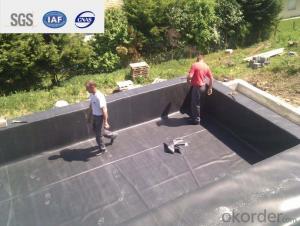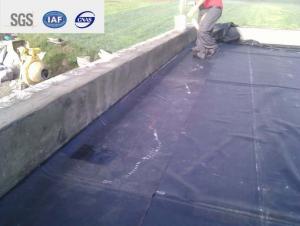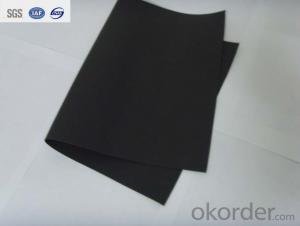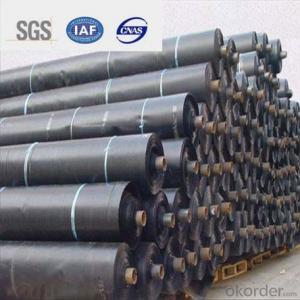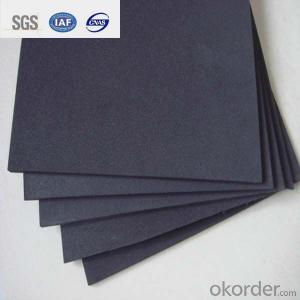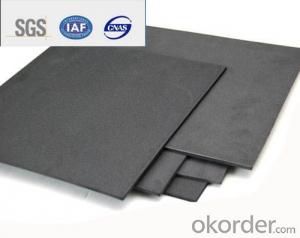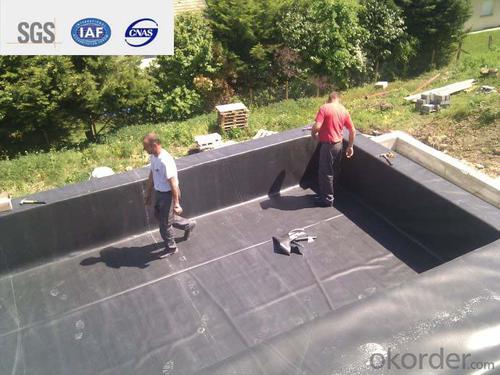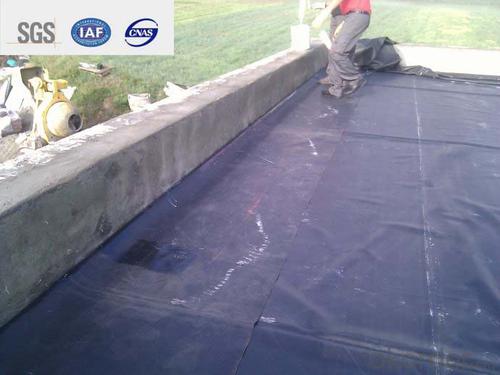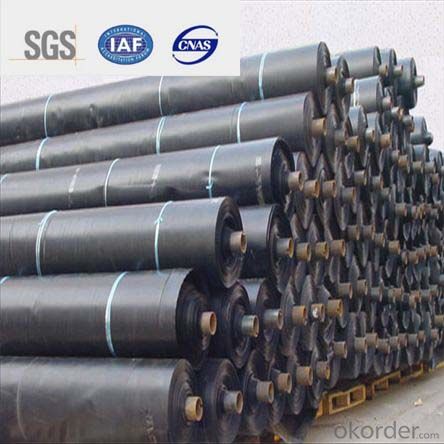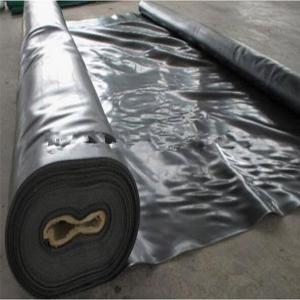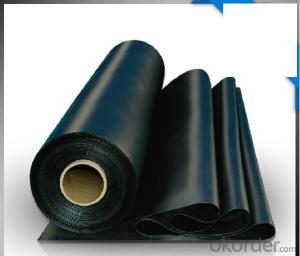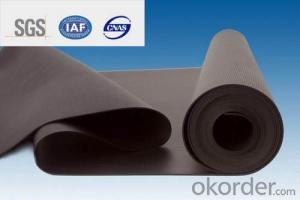EPDM Waterproofing Roofing Membrane for Roof 1.5mm
- Loading Port:
- Qingdao
- Payment Terms:
- TT OR LC
- Min Order Qty:
- 2000 m²
- Supply Capability:
- 800000 m²/month
OKorder Service Pledge
OKorder Financial Service
You Might Also Like
Description Of EPDM Rubber Waterproof Membrane:
1. EPDM waterproof membrane is made from ternary ethylene-propylene rubber, which is for waterproofing of exposed and non-exposed applications.
2. EPDM waterproof membrane production adopts the world-advanced equipment of cold feeding extrusion and continuous vulcanization technology.
3. EPDM waterproof membrane is of high elasticity among high polymer waterproof materials and becomes a world-popular waterproofing material.
Main Features of EPDM Rubber Waterproof Membrane:
1. Excellent physical and mechanical performance
2. High tearing resistance
3. Good deformation adaptability
4. High puncture resistance
5. High aging resistance
6. UV resistance
Specifications of EPDM Rubber Waterproof Membrane:
Material | EPDM Rubber |
Size | 1.2m (width)*20m (length) or customized, weldable type 2.05m or 4m width |
Thick | 1.2mm, 1.5mm, 2.0mm |
Type | Vulcanized & Weldable |
Pattern | Non-reinforced (homogeneous) |
Certificate | ISO9001/14001 |
Applications of EPDM Rubber Waterproof Membrane:
1.Roofs, Basement, Toilets
2. Industrial and civil building waterproofing
3. Geosynthetic liner for swimming pool, channels, irrigation system
4. Especially suitable for projects with high requirements in durability, anti-corrosion and deformation.
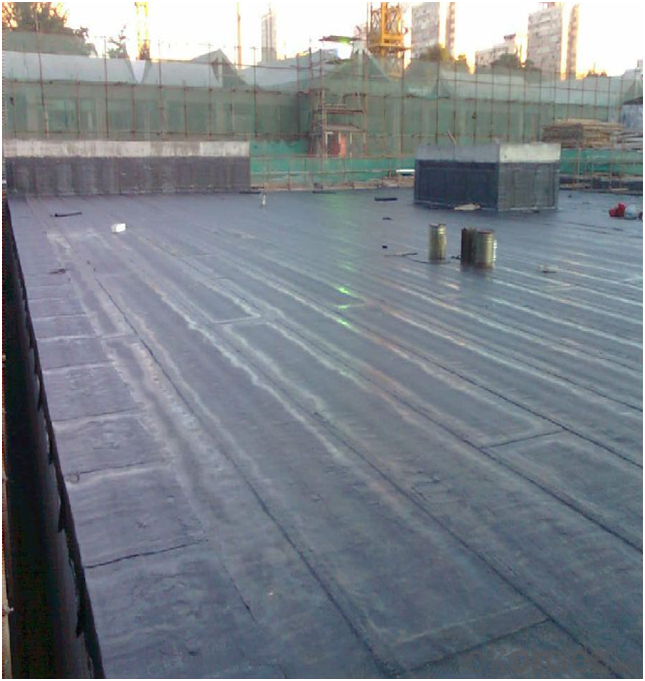
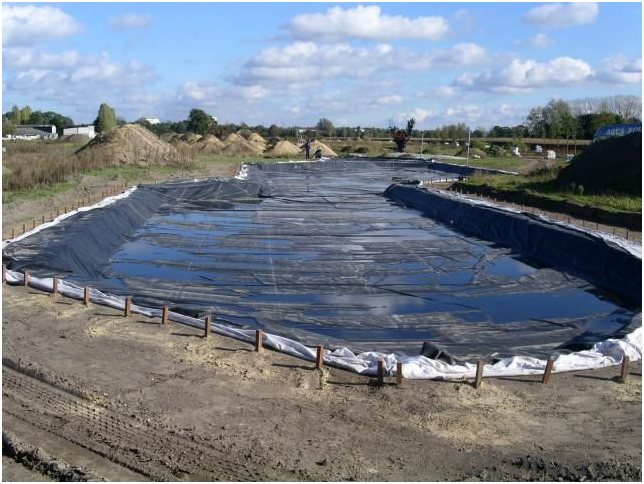
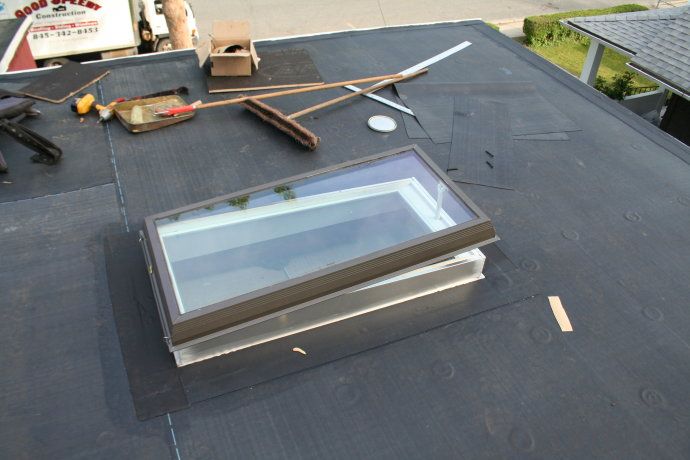
FAQ:
1. What are we supplying?
We are specialized in producing Colorful Asphalt Roof Shingle, SBS/APP modified bitumen waterproof membrane, Self adhesive bitumen waterproof membrane, PVC waterproofing membrane, EPDM rubber roofing membrane, Single Component Polyurethane Waterproof Coating, and Spray Polyurea Waterproof Coating.
2. How Many years experience do we have?
We have been exported to more than 20 countries in the past 15 years.
3. How long do we usually reply your request?
We always reply our customer within 24 hours.
- Q: Can a waterproofing membrane be used in chemical or hazardous environments?
- Indeed, a waterproofing membrane proves effective in chemical or hazardous surroundings. Its purpose is to serve as a barrier against water, moisture, and other liquids, including chemicals and hazardous substances. Typically, these membranes are constructed from chemical-resistant materials like polyurethane, PVC, or modified bitumen. This composition ensures their durability and ability to withstand exposure to various chemicals without harm. Nevertheless, it is vital to choose a waterproofing membrane specifically designed for chemical or hazardous environments to guarantee compliance with necessary requirements and standards. Moreover, proper installation and maintenance play a crucial role in ensuring the long-lasting effectiveness of the waterproofing membrane in such settings.
- Q: Does a waterproofing membrane have any impact on the indoor air quality?
- The impact of a waterproofing membrane on indoor air quality should not be underestimated. Waterproofing membranes, commonly used to prevent water infiltration in moisture-prone areas like basements, roofs, and foundations, are typically made of synthetic materials like polyethylene or polypropylene. Unfortunately, these materials can release volatile organic compounds (VOCs) into the air. VOCs are chemicals that can evaporate at room temperature and have negative effects on indoor air quality. They contribute to the formation of indoor air pollutants, including formaldehyde and benzene. Prolonged exposure to VOCs can result in health issues such as eye, nose, and throat irritation, headaches, dizziness, and respiratory problems. However, it's important to note that not all waterproofing membranes have the same impact on indoor air quality. Some manufacturers have developed low VOC or VOC-free membranes that aim to minimize the release of harmful chemicals. These products undergo rigorous testing to meet stringent air quality standards. In addition, proper installation and ventilation are crucial in mitigating any potential negative impact on indoor air quality. Adequate ventilation systems help eliminate VOCs and other pollutants, preventing them from accumulating and causing health problems. Therefore, when considering the installation of a waterproofing membrane, it's crucial to select a product that has been tested for low VOC emissions and ensure proper ventilation is in place to maintain good indoor air quality. Seeking guidance from professionals in the field can assist in choosing the most suitable waterproofing solution for specific needs while minimizing any potential impact on indoor air quality.
- Q: Are waterproofing membranes resistant to mold and mildew?
- Yes, waterproofing membranes are generally resistant to mold and mildew. These membranes are designed to create a barrier against moisture, preventing it from seeping into the structure and causing mold and mildew growth. Waterproofing membranes are often made from materials such as rubber, PVC, or bitumen, which are not conducive to mold and mildew growth. Additionally, these membranes are installed in a way that ensures proper drainage and ventilation, further reducing the chances of mold and mildew formation. However, it is important to note that while waterproofing membranes can greatly reduce the risk of mold and mildew, they are not foolproof. It is still essential to maintain proper ventilation and address any water leaks or damage promptly to prevent mold and mildew growth.
- Q: How are waterproofing membranes installed?
- To safeguard buildings and structures from water damage, the application of waterproofing membranes is essential. Typically, the installation process involves multiple steps. Initially, the designated surface must be adequately prepared. This entails cleansing the surface and eliminating any debris or loose materials. Ensuring the surface is smooth and devoid of irregularities or cracks is of utmost importance. Following this, a primer is administered to the surface. This aids in establishing a robust bond between the membrane and the surface. Typically, a brush or roller is employed to apply the primer, and it is crucial to allow it to completely dry before proceeding to the subsequent step. Once the surface is primed, the waterproofing membrane can be installed. Various types of membranes are available, including sheet membranes, liquid membranes, and peel-and-stick membranes. The selection of the membrane type depends on the project's requirements and the surface being waterproofed. For sheet membranes, the material is typically unrolled and carefully positioned over the primed surface. It is crucial to ensure the proper alignment of the membrane, devoid of any wrinkles or air pockets. Subsequently, the membrane is firmly pressed down to establish a robust bond with the surface. Liquid membranes are usually applied using a brush or roller. The liquid is evenly spread over the primed surface, and multiple coats may be applied to ensure a comprehensive and effective waterproofing layer. Each coat must be allowed to dry before proceeding to the next. Peel-and-stick membranes are the simplest to install. The backing is peeled off the membrane, and it is meticulously pressed onto the primed surface. The adhesive on the membrane's back establishes a strong bond with the surface. Once the membrane is installed, any seams or joints must be adequately sealed. This is typically achieved using waterproofing tape or sealant. The objective is to create a continuous and watertight barrier to prevent any water from penetrating. Overall, the installation process for waterproofing membranes necessitates meticulous preparation, accurate application, and attention to detail. It is crucial to adhere to the manufacturer's instructions and utilize appropriate materials and techniques for the specific membrane being installed. By doing so, a dependable and efficient waterproofing system can be established, safeguarding the building or structure from water damage.
- Q: Can a waterproofing membrane be used on different types of surfaces, such as concrete, wood, or metal?
- A variety of surfaces, including concrete, wood, and metal, can benefit from the use of a waterproofing membrane. These membranes are designed to create a barrier that prevents water from causing damage by penetrating the surface. They are versatile and can adhere to different materials, making them suitable for various applications. For concrete surfaces, the application of a waterproofing membrane can protect against water intrusion and prevent issues such as cracks, corrosion, or mold growth. It is effective for concrete foundations, basements, or retaining walls, ensuring that they remain dry and structurally sound. When it comes to wood, a waterproofing membrane acts as a protective layer that prevents water absorption, warping, rotting, or decay. It is particularly useful for exterior surfaces like decks, balconies, or fences, as it enhances their lifespan and preserves their integrity. In the case of metal surfaces, a waterproofing membrane is capable of preventing rusting and corrosion caused by water exposure. By creating a barrier that seals out moisture, it protects metal roofs, gutters, or other metal structures from water damage. It is important to consider that different types of waterproofing membranes may be more suitable for specific surfaces. For instance, liquid-applied membranes are easily applied on irregular surfaces like concrete, while sheet membranes are more appropriate for flat or smooth surfaces. Consulting with a professional or manufacturer is advisable to determine the most suitable waterproofing membrane for a specific surface and application.
- Q: What is the typical installation process for a waterproofing membrane?
- Installing a waterproofing membrane typically involves several steps. Firstly, the surface requiring waterproofing is thoroughly cleaned and prepared by eliminating any existing coatings, debris, or loose materials. It is essential to guarantee that the surface is smooth, clean, and devoid of any contaminants that may hinder the membrane's adhesion. Secondly, any cracks, holes, or imperfections in the surface are repaired. This entails filling cracks with a suitable filler or patching compound and smoothing out rough areas. It is crucial to have a solid and even surface to ensure proper installation and efficacy of the waterproofing membrane. Once the surface is prepared, it is often necessary to apply a primer to enhance adhesion between the surface and the membrane. The primer is typically applied using a brush or roller, following the manufacturer's instructions. After the primer has dried, the waterproofing membrane is mounted. There are various types of membranes available, such as sheet membranes or liquid-applied membranes. Sheet membranes are usually rolled out onto the surface and adhered using an appropriate adhesive or mortar. Liquid-applied membranes are applied using a brush, roller, or spray equipment to create a continuous and seamless barrier. Throughout the installation process, it is crucial to ensure correct membrane installation with proper overlap or seams. Additionally, any penetrations or transitions must be adequately treated and sealed. This includes areas such as corners, edges, drains, and pipe penetrations, where additional detailing may be necessary to create a watertight seal. Once the membrane is installed, it is important to allow it to cure or dry according to the manufacturer's instructions. This ensures that the membrane reaches its maximum strength and waterproofing capabilities. Finally, after the membrane has cured, it may be beneficial to apply a protective layer or coating to enhance the durability and longevity of the waterproofing system. This may involve applying a topcoat, sealant, or protective barrier to shield the membrane from UV rays, foot traffic, or other potential sources of damage. In summary, the installation process for a waterproofing membrane includes surface preparation, primer application, membrane installation, detailing and sealing, curing, and potentially applying a protective layer. It is crucial to adhere to the manufacturer's instructions and consult with a professional if necessary to ensure proper and effective installation.
- Q: Can a waterproofing membrane be used on precast iron surfaces?
- Yes, a waterproofing membrane can be used on precast iron surfaces. The membrane acts as a barrier to prevent water penetration, protecting the iron surface from corrosion and water damage.
- Q: Can a waterproofing membrane protect against mold or mildew growth?
- Yes, a waterproofing membrane can help prevent mold or mildew growth by creating a barrier that keeps moisture out. By stopping water infiltration, it reduces the conditions necessary for mold and mildew to thrive, thus providing protection against their growth.
- Q: Can a waterproofing membrane be used on tunnels with emergency exits?
- Yes, a waterproofing membrane can be used on tunnels with emergency exits. In fact, it is highly recommended to use a waterproofing membrane in such tunnels to prevent water infiltration and protect the structural integrity of the exits. Waterproofing membranes are designed to create a barrier against water and moisture, ensuring that the tunnels remain dry and free from water damage. This is especially important for emergency exits, as they need to be accessible and functional at all times. By installing a waterproofing membrane, the tunnels can be effectively protected from potential water ingress, ensuring the safety and usability of the emergency exits.
- Q: Can a waterproofing membrane be used for a parking garage?
- Yes, a waterproofing membrane can be used for a parking garage. A waterproofing membrane is designed to provide a barrier against water infiltration, protecting the underlying structure from moisture damage. In a parking garage, where exposure to water and moisture is common due to rain, snow, and vehicle fluids, a waterproofing membrane can be a crucial component of the building envelope system. It can be applied to the concrete surfaces, including the floor and walls, to prevent water from seeping into the structure and causing deterioration, corrosion, or damage to the integrity of the parking garage. Additionally, a waterproofing membrane can also help to mitigate the risk of efflorescence, mold, and mildew growth, which can be common in damp environments. Therefore, using a waterproofing membrane in a parking garage is an effective way to ensure the long-term durability and functionality of the structure.
Send your message to us
EPDM Waterproofing Roofing Membrane for Roof 1.5mm
- Loading Port:
- Qingdao
- Payment Terms:
- TT OR LC
- Min Order Qty:
- 2000 m²
- Supply Capability:
- 800000 m²/month
OKorder Service Pledge
OKorder Financial Service
Similar products
Hot products
Hot Searches
Related keywords
